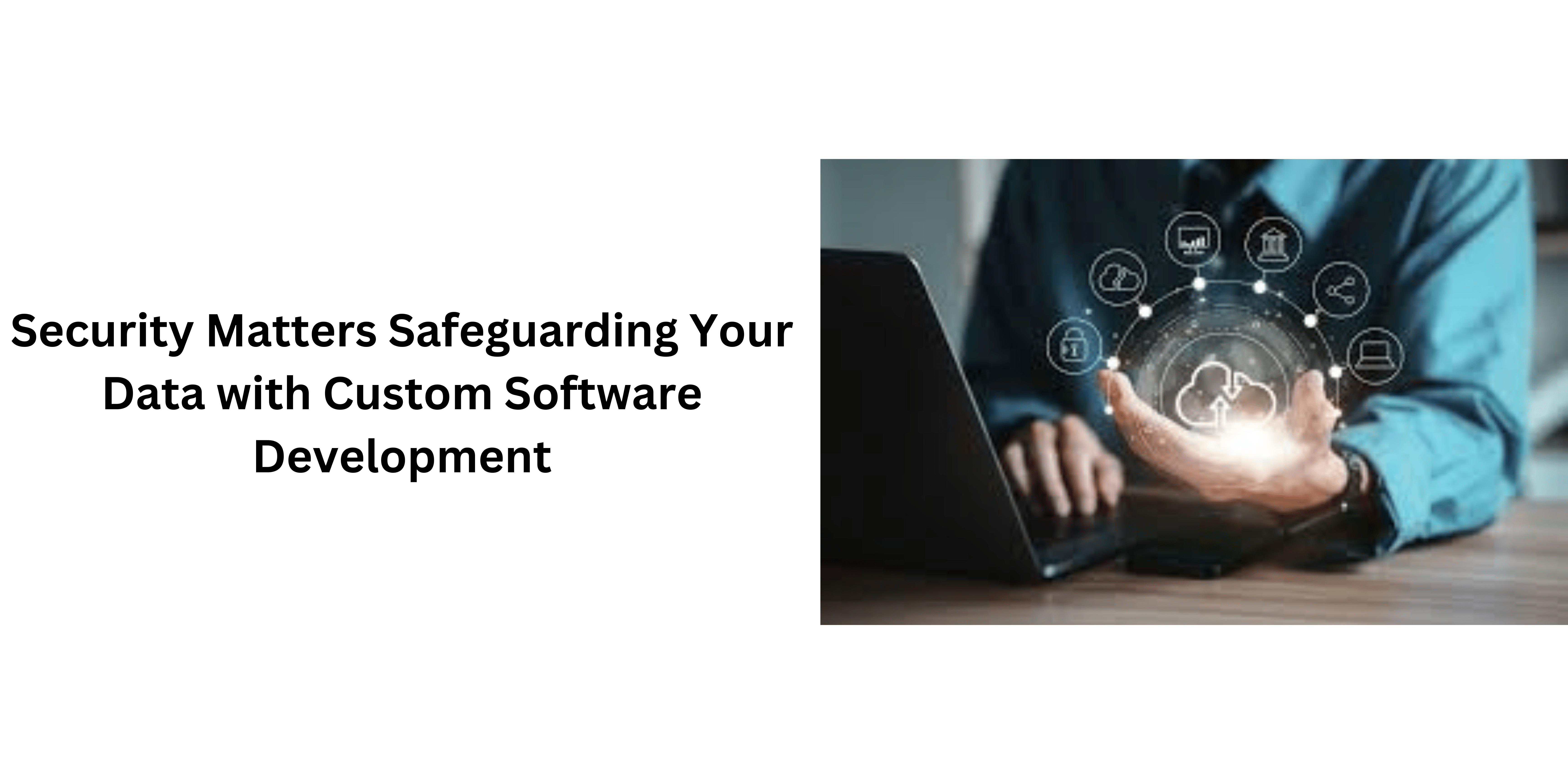In an era dominated by digital advancements, the protection of sensitive data has become a paramount concern for individuals and organizations alike. The increasing frequency and sophistication of cyber threats underscore the critical need for robust security measures. This brings into focus the pivotal role that custom software development plays in safeguarding valuable information. Custom software solutions, tailored to specific organizational needs, goes beyond generic solutions, providing a personalized shield against evolving security challenges.
This introduction explores the multifaceted landscape of data security, delving into the significance of custom software development as a proactive approach to fortify defenses. As we navigate the intricate realms of encryption, access control, and compliance, it becomes evident that a comprehensive security strategy is imperative. This discussion aims to unravel the layers of intricacy surrounding security matters, offering insights into the integration of advanced technologies, best practices, and emerging trends. Join us on a journey to understand how custom software development serves as a linchpin in the ongoing battle to protect sensitive data in our rapidly evolving digital ecosystem.
The Role of Custom Software Development in Data Protection
In the ever-evolving landscape of data protection, custom software development emerges as a linchpin, offering tailored solutions to address the unique challenges faced by organizations in safeguarding their information assets. Unlike off-the-shelf software, custom solutions are designed with a laser focus on specific business requirements, allowing for a more robust and personalized defense against potential threats.
The role of custom software development in data protection is multifaceted. Firstly, customization enables organizations to implement security features that align precisely with their operational needs. This includes the integration of advanced encryption techniques, access controls, and authentication mechanisms tailored to the nature and sensitivity of the data being handled.
Furthermore, custom software allows for regular updates and adaptations to keep pace with the dynamic landscape of cyber threats. Unlike standardized software that may have a one-size-fits-all approach, custom solutions can evolve in real-time, addressing emerging vulnerabilities and staying resilient against evolving attack vectors.
Custom software development also plays a crucial role in incident response planning. Organizations can build specific functionalities to detect and mitigate security breaches promptly. This proactive approach enhances the overall cybersecurity posture, minimizing the potential impact of data breaches.
Moreover, compliance with industry and regulatory standards is seamlessly integrated into custom software solutions. Whether it be GDPR, HIPAA, or other regional data protection regulations, custom development ensures that the software aligns with and supports adherence to these standards, reducing the risk of legal and financial repercussions.
In essence, the role of custom software development in data protection is pivotal, providing a tailored, proactive, and adaptive approach to safeguarding sensitive information in an increasingly complex and dynamic digital environment.
Understanding Security Threats in the Digital Landscape
In the contemporary digital landscape, understanding security threats is paramount for organizations seeking to fortify their defenses against malicious actors. The expansive and interconnected nature of the digital realm has given rise to a diverse array of security threats that can compromise the confidentiality, integrity, and availability of sensitive data.
One prevalent threat is malware, encompassing viruses, worms, trojans, and ransomware. These malicious programs infiltrate systems, often undetected, with the potential to corrupt, steal, or encrypt valuable data. Phishing attacks, another common threat, exploit human vulnerabilities through deceptive emails or websites, aiming to trick individuals into divulging confidential information.
Cyberattacks also frequently involve exploitation of software vulnerabilities. As technology advances, so do the techniques of hackers who exploit weaknesses in applications, operating systems, or third-party plugins. Denial-of-service (DoS) and distributed denial-of-service (DDoS) attacks pose a threat to the availability of digital services by overwhelming systems with traffic, rendering them inaccessible.
The rise of social engineering as a sophisticated threat involves manipulating individuals into divulging confidential information. This can include impersonation, pretexting, or baiting tactics, highlighting the human element as a potential vulnerability in the security chain.
Understanding these threats necessitates a comprehensive approach that goes beyond technological safeguards. It involves educating users about potential risks, implementing robust cybersecurity policies, and staying abreast of evolving threat landscapes. Organizations must continually update and adapt their security measures to anticipate and counteract emerging threats, acknowledging that cybersecurity is an ongoing, dynamic challenge in the ever-evolving digital ecosystem.
Tailoring Solutions: Benefits of Custom Software for Data Security
Tailoring solutions through custom software development offers a plethora of benefits for enhancing data security in an increasingly complex digital environment. Unlike off-the-shelf software solutions that provide a generic approach, custom software is specifically designed to address the unique needs and challenges of an organization, contributing significantly to bolstering data protection measures.
One primary advantage is the ability to implement personalized security features. Custom software allows organizations to integrate advanced encryption algorithms, access controls, and authentication mechanisms tailored to the nature and sensitivity of their data. This level of customization ensures that security measures align precisely with the specific requirements and risk profile of the organization.
Moreover, custom software facilitates regular updates and adaptations to evolving security threats. In contrast to pre-packaged software that may have fixed release schedules, custom solutions can be modified in real-time to address emerging vulnerabilities. This dynamic responsiveness is crucial for staying ahead of potential security risks and maintaining a proactive security posture.
Another notable benefit is the inclusion of incident response capabilities within the custom software. Organizations can embed functionalities to detect, analyze, and mitigate security breaches swiftly. This proactive approach minimizes the impact of potential data breaches and contributes to a more resilient overall cybersecurity strategy.
Custom software development also supports compliance with industry and regulatory standards. Whether adhering to GDPR, HIPAA, or other data protection regulations, organizations can ensure that their software aligns seamlessly with these requirements, reducing legal and financial risks.
In essence, the benefits of custom software for data security are rooted in its adaptability, personalization, and proactive response capabilities. By tailoring solutions to specific needs, organizations can establish a robust defense against evolving threats, safeguarding their sensitive information with a heightened level of precision and effectiveness.
Key Components of a Robust Security Strategy
Crafting a robust security strategy is essential to safeguard sensitive information in the face of evolving digital threats. This strategy encompasses a comprehensive approach, integrating key components that collectively contribute to a resilient defense against potential breaches.
Risk Assessment and Analysis
Understanding the unique risks an organization faces is foundational. This involves identifying potential threats, vulnerabilities, and assessing the impact of security incidents.
Access Controls and Authentication
Implementing stringent access controls ensures that only authorized individuals have entry to sensitive data. Multi-factor authentication adds an extra layer of security by requiring multiple forms of verification.
Encryption
The encryption of data at rest and in transit is a fundamental component of a robust security strategy. This cryptographic technique ensures that even if unauthorized access occurs, the intercepted data remains indecipherable without the proper encryption keys.
Regular Security Audits
Conducting regular security audits and vulnerability assessments is crucial for identifying weaknesses in the system. This proactive approach allows for timely remediation before potential threats exploit vulnerabilities.
Incident Response Plan
A well-defined incident response plan outlines the steps to be taken in the event of a security breach. This includes detection, containment, eradication, recovery, and lessons learned for future prevention.
Employee Training and Awareness
Human error is a common factor in security breaches. Educating employees on security best practices, phishing awareness, and the importance of strong password hygiene mitigates this risk.
Firewalls and Intrusion Detection Systems (IDS)
Deploying firewalls and IDS adds an additional layer of defense against unauthorized access and potential attacks, helping to monitor and control network traffic.
Patch Management
Keeping software and systems up-to-date with the latest security patches is critical for addressing known vulnerabilities and reducing the risk of exploitation.
Data Backups
Regularly backing up data ensures that in the event of a security incident or data loss, organizations can recover and restore information, minimizing downtime.
Security Policies and Procedures
Establishing and enforcing comprehensive security policies and procedures sets the groundwork for a secure operational environment, ensuring consistency in security practices across the organization.
By integrating these key components into a holistic security strategy, organizations can create a resilient defense posture, mitigating risks and proactively protecting their data from an array of potential threats in the ever-evolving digital landscape.
Encryption Techniques for Enhanced Data Privacy
Encryption stands as a cornerstone in the realm of cybersecurity, playing a pivotal role in enhancing data privacy and safeguarding sensitive information from unauthorized access with custom software solutions. This sophisticated technique involves encoding data in such a way that only authorized parties possess the means to decipher and interpret the information, ensuring confidentiality and integrity throughout data transmission and storage.
One commonly employed encryption technique is symmetric-key encryption, where the same key is used for both encryption and decryption. This method is efficient for securing large volumes of data but requires a secure channel for key exchange. As an alternative, asymmetric-key encryption involves a pair of keys – a public key for encryption and a private key for decryption. This method eliminates the need for a secure key exchange channel but may be computationally more intensive.
Transport Layer Security (TLS) and its predecessor, Secure Sockets Layer (SSL), are cryptographic protocols widely used to secure communication over a computer network. Employed in web browsers for secure connections, TLS ensures data privacy during online transactions by encrypting information such as credit card details.
End-to-end encryption is another powerful technique that secures data from the point of origin to the final destination. This method ensures that only the intended recipient, possessing the decryption key, can access and decipher the transmitted information. Messaging apps and secure email services often leverage end-to-end encryption to fortify user communication.
Encryption not only serves as a shield against eavesdropping and unauthorized access but also aids in regulatory compliance, addressing data protection laws and privacy standards. As technology advances, encryption techniques evolve, providing a dynamic defense against emerging cyber threats and contributing significantly to the preservation of data privacy in our interconnected digital world.
Authentication and Access Control Measures
Authentication and access control measures constitute the first line of defense in securing digital assets and sensitive information within an organization. These twin components work in tandem to ensure that only authorized individuals gain access to specific resources, reducing the risk of unauthorized access and potential data breaches.
Authentication: Authentication is the process of verifying the identity of a user, system, or device attempting to access a network or application. Common authentication methods include:
- Username and Password: Traditional but still widely used, requiring users to enter a unique username and a confidential password.
- Multi-Factor Authentication (MFA): Enhances security by requiring multiple forms of identification, such as passwords, biometrics, or security tokens, making it more challenging for unauthorized individuals to gain access.
- Biometric Authentication: Uses physical or behavioral traits, such as fingerprints, facial recognition, or voice patterns, to authenticate users, offering a higher level of security and convenience.
Access Control: Access control involves regulating and managing user access to systems, applications, or data based on their authenticated credentials. Key components include:
- Role-Based Access Control (RBAC): Assigns access permissions based on the roles individuals hold within an organization, ensuring that users have the necessary permissions for their specific job functions.
- Attribute-Based Access Control (ABAC): Grants access based on attributes such as user characteristics, environmental conditions, or resource properties, allowing for more dynamic and flexible access control.
- Access Policies: Define rules and conditions for granting or denying access, specifying who can access what resources under which circumstances.
These authentication and access control measures not only protect against unauthorized access but also contribute to regulatory compliance and adherence to data protection standards. As cyber threats continue to evolve, implementing robust authentication and access control mechanisms remains a fundamental aspect of an organization’s overall cybersecurity strategy, fostering a secure and controlled digital environment.
Regular Audits and Vulnerability Assessments
Regular audits and vulnerability assessments are indispensable components of a proactive cybersecurity strategy, crucial for identifying, mitigating, and preventing potential security threats and weaknesses in an organization’s digital infrastructure.
Audits: Regular audits involve systematic examinations of an organization’s information systems, policies, and procedures to assess compliance with security standards, regulatory requirements, and internal protocols. These audits may include:
- Internal Audits: Conducted by an organization’s internal team to evaluate adherence to internal policies and procedures, ensuring that security controls are implemented effectively.
- External Audits: Carried out by third-party entities to provide an unbiased assessment of an organization’s security posture, often focusing on regulatory compliance and industry best practices.
- Compliance Audits: Specifically target adherence to legal and regulatory requirements, ensuring that the organization meets standards such as GDPR, HIPAA, or other industry-specific regulations.
Vulnerability Assessments: Vulnerability assessments involve the systematic identification and evaluation of potential weaknesses in a system, network, or application. Key aspects include:
- Scanning and Testing: Automated tools and manual testing techniques are employed to identify vulnerabilities, misconfigurations, and potential points of exploitation.
- Risk Prioritization: Vulnerabilities are assessed based on their potential impact and likelihood of exploitation, allowing organizations to prioritize remediation efforts effectively.
- Continuous Monitoring: Regular assessments are conducted to account for changes in the threat landscape and evolving vulnerabilities, ensuring ongoing security resilience.
By conducting regular audits and vulnerability assessments, organizations can proactively detect and address security gaps, reducing the risk of data breaches and unauthorized access. These practices not only enhance the overall security posture but also contribute to regulatory compliance and the establishment of a robust cybersecurity framework capable of adapting to the dynamic nature of cyber threats in software development industry.
Incident Response Planning: A Crucial Element in Data Security
Incident response planning is a critical element in data security, serving as a structured and strategic approach to managing and mitigating security incidents effectively. This proactive methodology ensures that organizations are well-prepared to detect, respond to, and recover from security breaches, minimizing the impact on sensitive data and operational continuity.
Preparation
Establishing an incident response team, defining roles and responsibilities, and developing comprehensive incident response policies and procedures are foundational steps. This includes creating communication plans and identifying key stakeholders.
Detection and Analysis
Implementing monitoring tools and techniques to detect potential security incidents in real-time. Once detected, a thorough analysis is conducted to understand the nature and scope of the incident.
Containment
Taking immediate actions to contain the incident and prevent further damage or unauthorized access. This may involve isolating affected systems, disabling compromised accounts, or blocking malicious activities.
Eradication
Identifying the root cause of the incident and eliminating it from the environment. This phase aims to ensure that the vulnerabilities exploited by the incident are addressed to prevent recurrence.
Recovery
Initiating measures to restore affected systems, data, and services to normal operation. This includes validating the integrity of restored systems and conducting post-incident reviews to improve future responses.
Communication
Maintaining transparent and timely communication with internal stakeholders, external partners, and, if necessary, regulatory bodies. This ensures that all relevant parties are informed and can collaborate effectively during and after an incident.
Benefits of Incident Response Planning:
- Minimized Downtime: Swift and effective response reduces the duration of service interruptions and operational downtime.
- Reduced Impact: Timely containment and eradication measures mitigate the potential impact of a security incident on sensitive data and organizational assets.
- Legal and Regulatory Compliance: A well-defined incident response plan helps custom software development companies comply with data protection laws and regulations by demonstrating a proactive approach to security.
- Continuous Improvement: Post-incident reviews and analyses contribute to refining incident response strategies, enhancing the organization’s overall security posture.
In conclusion, incident response planning is not just a reactive measure but a proactive strategy that empowers organizations to navigate the complex landscape of data security, ensuring resilience, and minimizing the consequences of security incidents.
Custom Software Development Best Practices for Security
Custom software development best practices for security are imperative in creating robust applications that can withstand the ever-evolving landscape of cyber threats. Implementing these practices ensures that security is an integral part of the development life cycle, from the initial design phase to ongoing maintenance and updates.
Secure Coding Standards
Enforcing secure coding standards is foundational. Developers should adhere to recognized coding guidelines, such as those from OWASP, to mitigate common vulnerabilities and weaknesses in the codebase.
Threat Modeling
Conducting threat modeling early in the development process helps identify potential security risks and vulnerabilities. This proactive approach allows for the integration of appropriate security controls.
Regular Security Training
Ensuring that developers and other team members receive regular security training is crucial. This empowers them to stay informed about the latest security threats, attack vectors, and best practices.
Code Reviews and Static Analysis
Regular code reviews and static analysis tools are essential for identifying security issues before the software is deployed. Automated tools can catch common vulnerabilities, while manual code reviews provide a deeper analysis.
Encryption and Data Protection
Implementing strong encryption for data at rest and in transit is a fundamental best practice. This safeguards sensitive information from unauthorized access or interception.
Access Controls and Authentication
Robust access controls and authentication mechanisms, such as multi-factor authentication, should be in place to ensure that only authorized users have access to specific functionalities and data.
Patch Management
Regularly updating software components, libraries, and dependencies helps address known vulnerabilities. Patch management is critical for maintaining a secure software environment.
Security Testing
Conducting thorough security testing, including penetration testing and dynamic analysis, helps identify and remediate vulnerabilities in the application.
Least Privilege Principle
Adhering to the principle of least privilege ensures that individuals or systems have only the minimum level of access necessary to perform their tasks, reducing the risk of unauthorized actions.
Incident Response Plan
Having a well-defined incident response plan enables the team to respond swiftly and effectively in the event of a security incident, minimizing potential damage and downtime.
By integrating these best practices into the custom software development process, organizations can create resilient applications that prioritize security, safeguarding data and user information against a myriad of potential threats.
Addressing Compliance Requirements in Software Design
Addressing compliance requirements in software design is essential to ensure that custom software applications adhere to relevant laws, regulations, and industry standards. Incorporating compliance considerations into the design phase of software development helps organizations proactively meet legal and regulatory obligations, mitigating the risk of legal consequences and reputational damage.
Understanding Applicable Regulations
Identify and comprehend the specific regulations and standards applicable to the industry and geographic regions in which the software will operate. Common examples include GDPR, HIPAA, PCI DSS, and others.
Data Protection by Design
Implement a “privacy by design” approach, where data protection features are integrated into the software architecture from the outset. This includes encryption, access controls, and mechanisms for handling sensitive information securely.
Documentation and Traceability
Maintain comprehensive documentation detailing how the software design aligns with compliance requirements. This facilitates auditing and regulatory assessments, providing evidence of adherence to standards.
Secure Authentication and Access Controls
Implement robust authentication mechanisms and access controls to ensure that only authorized users have access to specific functionalities and data. This is particularly crucial for compliance with data protection regulations.
Audit Trails and Logging
Incorporate audit trails and logging mechanisms that capture relevant events and actions within the software. This aids in monitoring, analysis, and compliance reporting.
Consent Management
If applicable, integrate features for managing user consent, ensuring that the software respects privacy preferences and consent requirements outlined in regulations like GDPR.
Regular Compliance Assessments
Conduct regular assessments to verify ongoing compliance with evolving regulations. This includes periodic reviews of software design, functionality, and data handling practices.
Vendor Management
If third-party components or services are utilized, assess and ensure that these vendors also adhere to relevant compliance standards, as their non-compliance can impact the overall compliance of the software.
Collaboration with Legal and Compliance Teams
Foster collaboration between software development teams and legal or compliance experts. This ensures a comprehensive understanding of regulatory requirements and facilitates the incorporation of necessary controls.
Training and Awareness
Ensure that development teams are educated about compliance requirements, fostering a culture of awareness and responsibility throughout the software development life cycle.
By integrating these practices into software design, organizations can create applications that not only meet functional requirements but also align with legal and regulatory expectations. This approach promotes a secure and compliant software environment, reducing the risk of legal complications and instilling confidence among users and stakeholders.
Data Backups and Recovery Strategies
Data backups and recovery strategies are integral components of an organization’s comprehensive approach to data management and cybersecurity. These strategies are designed to safeguard against data loss, whether due to accidental deletion, hardware failure, cyberattacks, or other unforeseen events.
Data Backup Best Practices:
- Regular Backup Schedule: Establish a routine schedule for data backups, ensuring that critical information is consistently and systematically copied to a secure location. The frequency of backups may vary based on the organization’s needs and the nature of the data.
- Automated Backup Processes: Implement automated backup processes to reduce the risk of human error and ensure that backups occur consistently. Automation helps custom software development company to maintain the reliability of the backup schedule.
- Offsite and Cloud Backups: Store backups in geographically diverse locations or in the cloud to mitigate risks associated with on-premises disasters, such as fires, floods, or physical theft.
- Versioning: Retain multiple versions of files, enabling the restoration of data to specific points in time. This is particularly beneficial in scenarios where data corruption or unauthorized changes are discovered after the fact.
- Encryption of Backups: Apply encryption to backup data to protect sensitive information during storage and transmission. This safeguards the integrity and confidentiality of the backed-up data.
Data Recovery Strategies:
- Incident Response Plan: Integrate data recovery procedures into the organization’s incident response plan, ensuring a coordinated and efficient response to data loss incidents.
- Regular Testing: Regularly test the backup and recovery processes to verify their effectiveness. Testing helps identify potential issues and ensures that recovery procedures are reliable and timely.
- Prioritization of Critical Systems: Identify and prioritize critical systems and data for rapid recovery. This ensures that essential operations can resume swiftly in the event of a data loss incident.
- Employee Training: Educate employees about the importance of data backups and their role in the recovery process. Awareness training contributes to a culture of data protection and resilience.
- Documentation: Maintain comprehensive documentation outlining data recovery procedures. This documentation should be readily available to the relevant personnel during recovery efforts.
By implementing robust data backup and recovery strategies, organizations can minimize the impact of data loss incidents, whether caused by technical failures, cyber threats, or other disruptions. These strategies contribute to business continuity, mitigate risks, and enhance overall resilience in the face of evolving cybersecurity challenges.
User Education and Security Awareness Programs
User education and security awareness programs are crucial components of a comprehensive cybersecurity strategy, aiming to empower individuals within an organization to recognize, understand, and mitigate potential security risks. These programs are designed to cultivate a culture of security consciousness among employees, reducing the likelihood of human-related security incidents.
Phishing Awareness
Educate users about the risks and characteristics of phishing attacks. Training should include recognizing suspicious emails, links, and requests for sensitive information.
Password Hygiene
Promote strong password practices, including the use of complex passwords, regular updates, and avoidance of password reuse. Multi-factor authentication (MFA) should also be encouraged.
Social Engineering Awareness
Raise awareness about social engineering tactics, such as impersonation and manipulation, to help employees recognize and resist attempts to exploit human vulnerabilities.
Device Security
Instruct users on the importance of securing their devices, including laptops, smartphones, and tablets. This involves installing updates promptly, using antivirus software, and employing device encryption.
Data Handling Best Practices
Train employees on proper data handling, emphasizing the importance of protecting sensitive information, securing physical documents, and using encryption when transmitting data.
Incident Reporting Procedures
Establish clear and accessible procedures for reporting security incidents. Users should feel empowered to report any suspicious activities or potential security breaches promptly.
Regular Training Sessions
Conduct periodic training sessions to reinforce security awareness and update employees on emerging threats and best practices. Continuous education helps keep security considerations at the forefront of employees’ minds.
Security Policies Acknowledgment
Ensure that employees are familiar with and acknowledge organizational security policies. Regularly update policies to align with evolving threats and technologies.
Simulated Security Exercises
Conduct simulated security exercises, such as phishing simulations or tabletop exercises, to provide hands-on experience and reinforce the lessons learned during training.
Reward and Recognition Programs
Establish programs to recognize and reward employees who demonstrate exemplary security practices. Positive reinforcement encourages a proactive approach to security.
User education and security awareness programs play a pivotal role in creating a resilient human firewall against cyber threats. By fostering a security-aware culture, organizations can significantly reduce the risk of security incidents stemming from human error, ultimately contributing to a more robust cybersecurity posture.
Integration of AI and Machine Learning for Proactive Security
The integration of Artificial Intelligence (AI) and Machine Learning (ML) into cybersecurity strategies is a transformative approach that empowers organizations to adopt proactive measures against evolving security threats. AI and ML technologies analyze vast amounts of data, identify patterns, and make intelligent predictions, enhancing the ability to detect and respond to security incidents in real-time.
Threat Detection and Prediction
AI and ML algorithms analyze historical data to identify patterns indicative of potential security threats. By continuously learning from new data, these technologies can predict and detect abnormal activities, signaling potential security incidents before they escalate.
Behavioral Analytics
AI and ML are instrumental in establishing baseline user and system behaviors. Deviations from these baselines, which may indicate malicious activity, trigger alerts, enabling rapid response and threat mitigation.
Anomaly Detection
ML models excel at identifying anomalies in network traffic, user behavior, and system activities. This proactive approach helps in early detection of suspicious patterns that might indicate a security breach.
Automated Incident Response
AI-driven automation can respond to security incidents in real-time, executing predefined actions based on the identified threat. This reduces the response time, minimizing the potential impact of security breaches.
Adaptive Security Measures
ML algorithms adapt to changing threat landscapes, enabling security systems to evolve and stay effective against new and sophisticated attack vectors. This adaptability is crucial for staying ahead of emerging threats.
Fraud Prevention and Authentication
AI and ML contribute to fraud prevention by analyzing patterns in transactions, user behaviors, and authentication attempts. This enhances the accuracy of fraud detection systems and improves overall authentication processes.
Phishing and Malware Detection
ML models can analyze email content, URLs, and file attachments to identify phishing attempts and detect malware. This is particularly valuable in preventing social engineering attacks and malware infections.
Vulnerability Management
AI can assist in prioritizing vulnerabilities based on their potential impact, helping organizations focus on patching the most critical weaknesses first.
By leveraging AI and ML for proactive security measures, organizations can strengthen their defenses against a wide range of cyber threats. This integration not only enhances threat detection but also enables adaptive and intelligent responses, fortifying the overall cybersecurity posture and reducing the risk of successful cyberattacks.
Emerging Trends in Custom Software Development for Data Protection
Custom software development for data protection is continually evolving to address the dynamic landscape of cybersecurity threats and compliance requirements. Several emerging trends in this field underscore the industry’s commitment to enhancing data security measures.
Zero Trust Architecture
Zero Trust assumes that no entity, whether inside or outside the organization, should be trusted by default. Custom software development is increasingly incorporating Zero Trust principles, ensuring continuous verification and validation of user and system identities, reducing the risk of unauthorized access.
Privacy-Preserving Technologies
With increasing concerns about data privacy, custom software development is integrating privacy-preserving technologies, such as homomorphic encryption and federated learning. These techniques enable data processing and analysis without exposing sensitive information, aligning with stringent privacy regulations.
Blockchain for Data Integrity
Blockchain technology is gaining prominence in custom software development for data protection. By providing a decentralized and immutable ledger, blockchain enhances data integrity, ensuring that once information is recorded, it cannot be tampered with, supporting data auditability and transparency.
Containerization and Microservices
Containerization and microservices architecture offer enhanced security by isolating components of custom software. This ensures that if one part is compromised, it doesn’t jeopardize the entire system, improving overall resilience and facilitating easier updates.
AI-Driven Threat Hunting
Leveraging artificial intelligence for proactive threat hunting is becoming a standard practice. AI algorithms analyze vast datasets to detect anomalies and potential security threats, enabling faster and more accurate incident response.
Edge Computing Security
As edge computing gains prominence, security considerations for data processed at the edge are becoming critical. Custom software development focuses on implementing robust security measures for devices and systems at the edge of the network.
Quantum-Safe Cryptography
With the advent of quantum computing, there is a growing emphasis on quantum-safe cryptography in custom software development. These cryptographic algorithms are designed to resist attacks from quantum computers, ensuring long-term data security.
Continuous Compliance Monitoring
Custom software development incorporates tools and practices for continuous compliance monitoring. This ensures that applications adhere to evolving regulatory requirements, reducing the risk of non-compliance.
As organizations grapple with increasingly sophisticated cyber threats and stringent data protection regulations, custom software development trends are aligning towards comprehensive and adaptive solutions that prioritize the safeguarding of sensitive information. These emerging trends collectively contribute to a resilient and forward-looking approach to data protection.
The Key Takeaway
In conclusion, the ever-evolving landscape of data protection demands a proactive and adaptive approach, and custom software development emerges as a vital tool in this pursuit. From incorporating advanced encryption techniques to leveraging artificial intelligence for threat detection, the trends in custom software development signify a commitment to fortifying the defenses against an array of cyber threats.
As organizations navigate the complexities of compliance, privacy, and the dynamic nature of security risks, the integration of emerging technologies and best practices underscores the commitment to safeguarding sensitive information.
The fusion of Zero Trust principles, privacy-preserving technologies, and blockchain with the resilience of containerization and microservices reflects a holistic strategy. By embracing these trends, custom software development not only addresses current challenges but also prepares organizations for the future, ensuring a secure and resilient digital ecosystem in the face of ongoing technological advancements and evolving cybersecurity landscapes.











